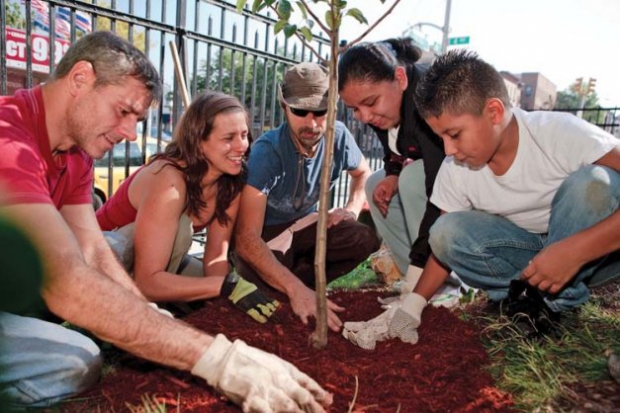
The Fruit Tree Planting Foundation depends on local volunteers not only to plant the trees but to learn how to maintain them and make them productive in the future.
Photos courtesy of the Fruit Tree Planting Foundation
For more than half a century, the great industrial cities of the northeastern United States have been decaying. From what used to be dynamic urban centers, people and industries have moved out, sprawling over adjacent farmland with homes, factories, roads, and shopping centers.
They leave behind abandoned houses and factories, abandoned land appropriately called brownfields. People are left behind, too, people too poor and unskilled to move, left trying to pay for city infrastructure too expensive to maintain. Poor education, poor crime control, poor fire control, poor roads, poor nutrition, unemployment, ever poorer people, are the result.
Instead of shopping for fresh fruits and vegetables at nice malls and supermarkets, inner city people buy food at small stores protected behind steel-barred windows. Often, it’s junk food.
In cities like Detroit and Flint, Michigan, many abandoned buildings have been demolished. In some areas, whole neighborhoods have been cleared and large fields have reappeared, land open for the first time in more than a century.
Not surprising, perhaps, a fruit orchard was planted in Flint, Michigan, this spring—210 bare-root peach, cherry, pear, and apple trees on 2.7 acres of land.
That wasn’t the only one. Orchards were also planted this spring in St. Louis, Cleveland, Atlanta, Chicago, and in Pittsburgh, to name the larger cities. It’s part of a plan being propelled by a nonprofit, charitable organization called the Fruit Tree Planting Foundation to plant orchards in communities across the United States. This urban orchard project is called Fruitful Neighborhoods.
It’s not just about trees, according to Cem Akin, the executive director. It’s about building new communities on the rubble of old cities—organized this time around people and their needs rather than industries like automobiles and steel.
Fruit trees symbolic
Community produce gardens have been popping in cities for many years. But something about fruit orchards spells permanency, a long-time commitment.
“We plant orchards anywhere we can find a core group of people committed to care for the orchard for the benefit of the local community,” Akin said. “We have a full application process. When we find a suitable sponsoring organization, then we look at the horticultural details.
“We provide many angles of support. We organize workshops, educate and train people, and make return visits. We make sure recipients are able to care for and maintain the orchard.
“We work all over the world. Our goal is to inspire the planting of 18 billion fruit trees,” he said. “We’ve done hundreds of projects.”
Recipients of trees must be nonprofit organizations, public schools, or government entities that own the planting site, are committed to caring for the trees, have irrigation available, and can coordinate volunteers on the day of planting.
The Fruit Tree Planting Foundation was started in 2002 by Dr. David Wolfe, who is the president. It’s located in Pittsburgh, Pennsylvania, and has a small staff of people scattered about the country who can work with local organizations that want to improve their communities by providing fresh fruit to local citizens.
All projects are implemented by the foundation’s arborists, including Rico Montenegro, Erik Wilson, and Akin, who coauthored The Home Orchard Handbook: A Complete Guide to Growing Your Own Fruit Trees Anywhere. Wilson went to Flint to supervise the planting there, which was carried out by more than 200 volunteers—local residents, students from Mott Community College and Kettering University, Mt. Morris Township police and firefighters, volunteers from United Parcel Service, and local and state officials, including the mayor of Flint. The program was sponsored by FTPF, UPS, and Earth Day Network.
The foundation has different kinds of programs aimed at different kinds of groups. “Fruit Tree 101,” for example, is targeted to public schools. “Communities Take Root” aims at city parks and community gardens. “Fruit Relief” is targeted at low-income neighborhoods and international hunger relief sites. “Reservation Preservation” builds projects on Native American reservations. “Roots of Recovery” targets health centers. And “Orchards for Animals” is for animal sanctuaries.
Ironic twist
This spring, Dr. Stephen Jones, a Detroit resident and an assistant professor of history at Central Michigan University, wrote an opinion piece in the online magazine Dome. He was responding to news reports that Michigan State University was proposing to create an urban-agriculture research center in the city, a project that could eventually cover 100 acres and involve an investment of $100 million. Researchers at the center would explore the possibilities of “vertical agriculture,” growing crops in multistory buildings, as well as new approaches to food cultivation that could conserve water and even produce energy.
“Over the last century, the city of Detroit has provided much of the human and economic capital that was needed to develop the vast suburbs of southeastern Michigan,” Jones wrote. “A century ago, the farms of Macomb, Oakland, Washtenaw, and western Wayne counties fed the urban center, but many of those farms have disappeared, replaced by houses, factories, and strip malls.
“Maybe now it is Detroit’s turn to feed those suburbs. There is a lot of open land in the city, and there is rapidly increasing interest in local production of food for ecological reasons.
“A number of interested groups have been eagerly promoting the idea of city farming for several years, but Detroit officials have been slow to embrace the idea. I don’t fully understand why, but I suspect a significant part of the reluctance is simply the conceptual issue: It is difficult to imagine farms as anything but the antithesis of cities.
“Farmland is what we’ve always cleared to build cities. To reverse the process can feel like we’re giving up on cities altogether.”
For more information, go to the Web site, www.ftpf.org.

Leave A Comment